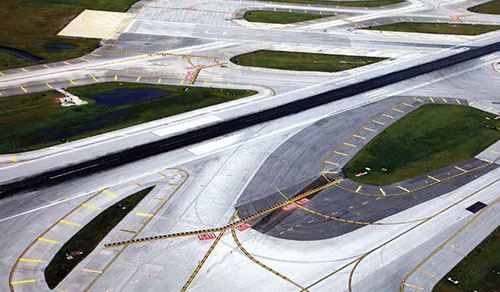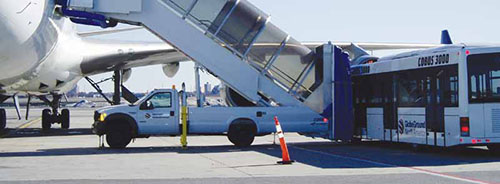Taxiway Modifications Ease Traffic Congestion During Runway Expansion at Fort Lauderdale Int'l
 In January, Fort Lauderdale-Hollywood International Airport (FLL) in Florida broke ground on a $791 million expansion of Runway 9R-27L that will claim it a spot of distinction in the U.S. airport system. When completed in 2014, the south end of the 8,000-foot runway will reside 65 feet above ground and extend over both railroad tracks and U.S. Highway 1.
In January, Fort Lauderdale-Hollywood International Airport (FLL) in Florida broke ground on a $791 million expansion of Runway 9R-27L that will claim it a spot of distinction in the U.S. airport system. When completed in 2014, the south end of the 8,000-foot runway will reside 65 feet above ground and extend over both railroad tracks and U.S. Highway 1.
In order to close the south runway for such work, FLL first needed to modify its north runway, 9L-27R, to handle additional capacity and prevent delays for both departing and arriving aircraft. Two new high-speed exit taxiways for east flow operations were added and an existing exit taxiway for west flow operations was widened. In addition, both connector taxiways A and B at the 27R approach end were also widened.
|
Project: Taxiway Modifications Location: Fort Lauderdale-Hollywood (FL) Int'l Airport Cost: $20.7 million Timeline: March 2011 - Feb. 2012 Owner: Broward County Aviation Dept. Prime Contractor: Central Florida Equipment Rentals Designer/Engineer: RS&H |
The $20.7 million improvements, which spanned from last March to this February, created a chain reaction of changes to aircraft traffic that improves overall flow, notes Gasser Dougé, P.E., project manager for the Broward County Aviation Department. Arriving aircraft now exit the north runway at a faster rate, which leaves the runway open for another departure or landing earlier than previously allowed, explains Dougé. The time saved during landing operations also allows FLL's tower to space arriving aircraft more closely, which further reduces delays, he adds.
"The high-speed exits gave us the efficiencies we needed for a single runway prior to the shutdown of the south Runway 9R-27L," says Dougé.
 The widening of taxiways A and B allows controllers to "stack" aircraft side by side, he adds. The change helps expedite traffic by allowing two aircraft to cross Runway 27R simultaneously.
The widening of taxiways A and B allows controllers to "stack" aircraft side by side, he adds. The change helps expedite traffic by allowing two aircraft to cross Runway 27R simultaneously.
"This has resulted in greater runway capacity for both arriving and departing aircraft," he reports.
Prior to the recent taxiway modifications, aircraft were often delayed up 30 minutes, Dougé recalls. By using infrastructure changes to enhance capacity, FLL has not only increased its on-time departures and arrivals, but also improved passenger satisfaction, he notes.
Minimizing Closures
The taxiway modifications required prime contractor Central Florida Equipment Rentals to install 427 feet of reinforced concrete slabs over three buried jet fuel lines and work amid an active runway and taxiways. One of the toughest challenges faced by the project team was constructing a section of full-strength pavement over the jet fuel lines in just one week. To save time and ensure that the runway was ready to reopen on schedule, RS&H and Central Florida Equipment Rental developed a hybrid approach that used precast and cast-In-place elements.
By limiting the width, and ultimately the weight, of precast protection slabs, engineers ensured safe lifting at an economical construction while still meeting all soil bearing requirements, explains RS&H Project Manager Brian McInerney, PE. The design called for a minimum spacing of the precast protection slabs to allow for the required reinforcing steel lap. Using precast slabs limited the time crews spent tying reinforcing steel and placing concrete during the runway closure.
"The longitudinal reinforcing steel in the concrete slabs was threaded to allow for the reinforcement steel within the adjacent cast-in-place protective slabs to be connected to act as one monolithic protection slab following the complete placement," relates McInerney.
A pre-manufactured sacrificial steel form saddle was placed underneath the slabs for support, which allowed for low-strength material commonly known as flowable fill and full-strength structural concrete to be poured in quick succession and cure simultaneously while withstanding the vertical pressures, he adds.
"This simultaneous cure cut days off the critical path," McInerney notes.
The time available to widen taxiways A and B was also very limited, recalls Senior Project Manager Marcus Thermes.
Challenges aside, the local contractor was able to cut the planned 65-day runway closure down to 53 days. Value engineering and completing roughly $12 million of work in 20-hour days made the abbreviated schedule possible, says Thermes. Saving time helped abate shutdown-related losses for air carriers, he adds.
"The team was able to shut the runway down for seven days to give us time to accomplish the critical work," Thermes recalls. After the closure, crews operated within the runway safety area, simultaneously working in five different locations along the entire length of the 9,000-foot north runway.
Except during the seven-day shutdown, FLL maintained limited flight operations on Runway 9L-27R throughout the 53-day construction project. Broward County Aviation Department coordinated with air carriers to allow takeoffs and landings from 5 p.m. to 9 p.m.; during the other 20 hours per day, traffic was diverted to 13-31, a 6,930-foot crosswind runway.
"Clearly, long-haul flights were impacted," Dougé relates, noting the airlines' schedule adjustments. In retrospect, Thermes considers the FLL taxiway modifications one of the best projects he's ever worked on. "There was excellent collaboration among airside operations, the design team, the owner and the FAA throughout the project," he notes.
Sneak Peek
A year before the FAA's Record of Decision approving FLL's south runway expansion, Broward County Aviation Department contracted RS&H to provide planning and design services for the high-speed exit taxiways on the north runway.
Runway Exit Design Interactive Model software was used to analyze several potential configurations, notes RS&H Project Manager Michael Moore, PE. The software modeled optimum taxiway exit locations, which resulted in the highest possible aircraft capture rate. This, explains Moore, lowered the time aircraft spend on the runway during landing operations. The analysis was performed for aircraft landing in both easterly and westerly directions, he adds.
SIMMOD software, which used highly detailed representations of FLL's airspace and airfield design, modeled taxiing operations to evaluate existing delays and develop improvements associated with the new high-speed exit taxiways and widened connector taxiways.
Airfield planning was particularly challenging because the existing crosswind runway, 13-31, was only 6,930 feet long and severely constrained on both ends by noise limitations, notes Moore. Out of consideration to developed areas surrounding the airport, commercial traffic on Runway 13-31 was kept to a minimum. It also led to the four-hour limit for long-haul flights on Runway 9L-27R.
"The improvements were successful in allowing aircraft to exit the runway at a faster rate," Moore summarizes. "This is reducing aircraft delays during the construction of the new south Runway 9R-27L, as well as during the eventual closing of the crosswind Runway 13-31, when the airport will be operating with only one runway."
With recent north runway modifications in full use, the airport is immersed in the elevated expansion of Runway 9R-27L. The much larger project is engineered to reduce overall flight delays and help FLL keep pace with the region's growing air traffic demands. While the airport currently handles 23.4 million passengers annually, increases of 7% to 10% are expected by 2015, note Broward County Aviation Department officials. Once the expansion project is finished, Runway 9R-27L will have the capacity to handle 450,000 annual takeoffs and landings. Completion is expected in fall 2014.
|
SIDEBAR
BRIDGING A TEMPORARY GAP |
FREE Whitepaper
Fairbanks International Airport Baggage Transport Conveyor Enhanced With Mod Drive™ System
Airports face a host of unique industry challenges, such as meeting efficiency regulations and seeking out the best maintenance practices to reduce costs and keep operations flowing. In today’s current economic climate, any potential cost savings can go a long way.
In 2019, Alaska’s Fairbanks International Airport (FAI) sought to modernize its equipment and operations. They were dissatisfied with the performance of the gearmotors on their baggage transport conveyors and began searching for new suppliers. Regal approached FAI with a solution that could improve equipment performance and simplify maintenance, with the added benefit of energy cost savings: the Hub City® MOD Drive™ system.
This white paper discusses the hardware deployed, the test results and the annualized expectations for ROI.
 factsfigures
factsfigures







